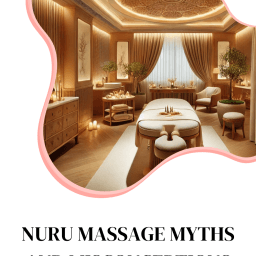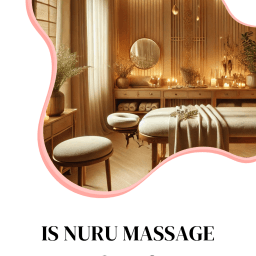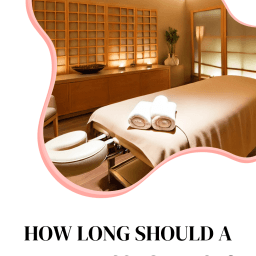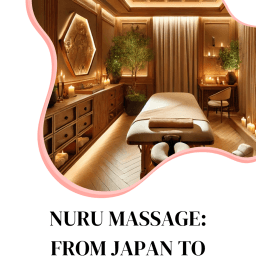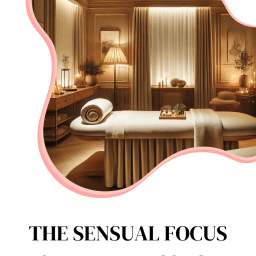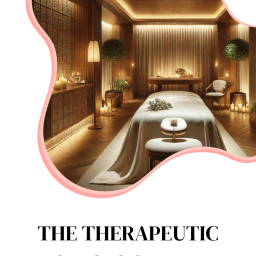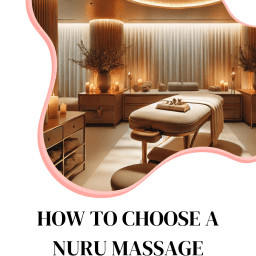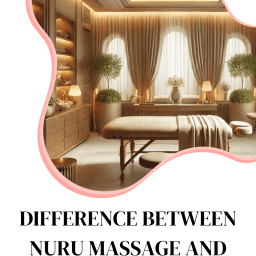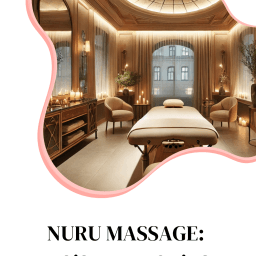
Nuru Massage vs. Other Massage Types (Thai, Swedish, Shiatsu)
1. Origins and Cultural Background
Understanding the origins and cultural history of each massage type reveals the unique philosophies and techniques behind them. Each practice reflects its cultural heritage, influencing how it is performed today, especially in cosmopolitan cities like Vienna, where diverse massage styles are available.
Nuru Massage
- Cultural Origin: Nuru massage is a modern practice that originated in Kawasaki, Japan. Although it draws inspiration from traditional Japanese massage techniques, it has evolved into a distinctive form of sensual bodywork.
- Historical Development: The word “Nuru,” meaning “slippery” in Japanese, aptly describes this massage’s defining characteristic. It traditionally uses a gel made from Nori seaweed, known for its smooth and gliding properties. Nuru massage emphasizes full-body skin-to-skin contact, creating an intimate experience. While it has gained global popularity for its relaxation and sensual benefits, it remains closely tied to its Japanese origins.
- Cultural Significance: In Japan, physical touch is considered a deeply healing practice. Nuru massage continues this tradition by focusing on both relaxation and intimacy. It thrives in private, serene settings that prioritize emotional connection.
Relaxation & Intimacy: Opt for Nuru massage to experience a unique, sensual full-body experience.
Thai Massage
- Cultural Origin: Thai massage, also known as “Nuad Thai,” has roots that date back more than 2,500 years. It is influenced by ancient healing traditions from India, China, and Southeast Asia.
- Historical Development: Thai massage is believed to have been founded by Jivaka Kumar Bhaccha, a physician to the Buddha. Over centuries, this practice became intertwined with traditional Thai medicine and Buddhist rituals. Originally performed in temples by monks, it was part of a holistic system combining spiritual guidance, herbal remedies, and meditation.
- Cultural Significance: Often referred to as “yoga massage,” Thai massage incorporates yoga-like stretches and positions into its therapy. It focuses on energy lines, known as “Sen,” which are believed to balance the body. This makes it both a physical and spiritual healing practice.
Swedish Massage
- Cultural Origin: Swedish massage was developed in the early 19th century by Per Henrik Ling, a Swedish physician and gymnastics teacher. However, its techniques integrate elements from traditional Chinese, Greek, Roman, and Hindu practices.
- Historical Development: Ling’s innovative method combined therapeutic touch, gymnastic exercises, and muscle manipulation. Over time, his system became the foundation of Western massage therapy, gaining popularity across Europe and North America.
- Cultural Significance: Swedish massage is now recognized globally as the standard form of therapeutic massage. Its primary focus on muscle relaxation has made it a staple in spas, wellness centers, and clinics worldwide.
Physical & Energy Healing: Select Thai massage for its yoga-like stretches and energy balance.
Shiatsu Massage
- Cultural Origin: Shiatsu, meaning “finger pressure” in Japanese, emerged in the early 20th century. This massage style blends the principles of Traditional Chinese Medicine (TCM) with Japan’s traditional anma massage.
- Historical Development: Rooted in TCM, Shiatsu applies pressure along the body’s meridians to balance energy (Qi). The practice was formalized by Tokujiro Namikoshi in the 1920s, who adapted traditional methods into a modern therapeutic framework. Shiatsu gained recognition as a clinical therapy in Japan.
- Cultural Significance: Today, Shiatsu is a central part of Japanese healthcare. It is widely valued for its ability to relieve physical and emotional discomfort, promote relaxation, and restore energy balance.
Massage Type | Cultural Origin | Historical Development | Cultural Significance |
Nuru Massage | Japan (Kawasaki) | Modern practice using seaweed-based Nuru gel for sensual, intimate relaxation. | Focuses on intimacy and relaxation. Deeply tied to Japanese traditions of healing touch and connection. |
Thai Massage | Thailand | Dates back over 2,500 years, influenced by Indian, Chinese, and Southeast Asian healing practices. | Combines physical stretching and spiritual energy balance. Performed traditionally in temples. |
Swedish Massage | Sweden | Developed in the 19th century by Per Henrik Ling, combining gymnastic movements with therapeutic touch. | A global standard for muscle relaxation and stress relief. Widely adopted in Western wellness practices. |
Shiatsu Massage | Japan | Formalized in the 1920s by Tokujiro Namikoshi. Draws from Traditional Chinese Medicine and Japanese anma massage. | Central to Japanese healthcare, emphasizing energy balance and holistic healing. |
Q: What makes Nuru massage different from other massage types?
A: Nuru massage stands out due to its use of Nuru gel and emphasis on skin-to-skin body sliding, focusing on relaxation and intimacy rather than muscle manipulation.
Q: Which massage type is best for improving flexibility?
A: Thai massage is ideal for enhancing flexibility, as it combines assisted stretching with acupressure techniques.
2. Techniques and Methods Used
Each massage type employs distinctive techniques and methods, catering to various preferences and therapeutic goals. Whether you seek deep muscle relief, energy alignment, or intimate relaxation, understanding these differences can help you choose the most suitable option.
Nuru Massage
- Key Techniques: Nuru massage is defined by full-body, skin-to-skin sliding motions. Both the client and masseur are covered in a specially formulated seaweed-based Nuru gel. This gel’s slippery texture allows for seamless, fluid movements. Unlike other massages that rely on hands or elbows, Nuru massage emphasizes body-on-body contact.
- Methods: Performed on a mat instead of a massage table, this technique focuses on creating a sensory experience. The masseur uses their entire body to glide over the client’s body, applying gentle pressure and motion. The aim is relaxation and heightened connection rather than deep muscle manipulation, making it uniquely intimate.
Thai Massage
- Key Techniques: Thai massage combines acupressure with yoga-like assisted stretches, earning its nickname “passive yoga.” Practitioners use their hands, elbows, knees, and feet to apply rhythmic pressure. Unlike Western massages, it does not involve oils, and clients remain fully clothed.
- Methods: Thai massage works along the body’s “Sen” energy lines, believed to connect to different organs and systems. By compressing and stretching muscles, it relieves tension, improves flexibility, and enhances energy flow. This dynamic method is often invigorating, making it distinct from more passive massage styles.
Stress Relief: Choose Swedish massage for a gentle, calming experience perfect for beginners.
Swedish Massage
- Key Techniques: Swedish massage is characterized by five core techniques:
- Effleurage: Long, gliding strokes.
- Petrissage: Kneading motions.
- Friction: Deep circular movements.
- Tapotement: Rhythmic tapping or hacking.
- Vibration: Gentle shaking motions.
- Methods: Performed on a massage table, Swedish massage uses oils or lotions to reduce skin friction. The strokes are designed to relax muscles, improve circulation, and promote lymphatic drainage. Therapists adjust the pressure and techniques based on the client’s needs, balancing relaxation with muscle tension relief.
Shiatsu Massage
- Key Techniques: Shiatsu relies on rhythmic pressure applied to specific acupressure points using thumbs, fingers, palms, and elbows. These points align with the body’s meridians, which are believed to influence physical and emotional health.
- Methods: Performed on a mat or low table, Shiatsu does not use oils, and clients remain fully clothed. The practitioner adjusts the pressure and stretches to suit the client’s energy and health needs. Shiatsu is less about muscle relaxation and more focused on energy healing, making it ideal for those seeking holistic wellness.
Massage Type | Key Techniques | Methods |
Nuru Massage | Full-body sliding motions using seaweed-based gel for skin-to-skin contact. | Performed on a mat. Masseur uses their entire body to glide over the client’s body, focusing on relaxation and sensory stimulation. |
Thai Massage | Combines acupressure with assisted yoga-like stretching. | Performed on a mat. Uses hands, elbows, knees, and feet to apply rhythmic pressure along energy lines, improving flexibility and stimulating energy flow. |
Swedish Massage | Five primary techniques: effleurage, petrissage, friction, tapotement, and vibration. | Performed on a table with oils or lotions. Focuses on relaxing muscles, improving circulation, and relieving tension through targeted pressure and movements. |
Shiatsu Massage | Rhythmic pressure applied to acupressure points along meridian lines using thumbs, fingers, palms, and elbows. | Performed on a mat or low table. Tailored pressure and stretching techniques restore energy balance and address physical and emotional health. |
Q: Can Shiatsu massage help with chronic pain?
A: Yes, Shiatsu massage targets meridian points to alleviate muscle stiffness, migraines, and joint pain, offering holistic pain relief.
Q: Is Swedish massage suitable for beginners?
A: Absolutely. Swedish massage is known for its gentle techniques, making it perfect for those new to massage therapy.
3. Physical Benefits of Each Massage
Massage therapy offers diverse physical benefits. Each type focuses on unique techniques to address specific physical needs. Below, we explore the key physical benefits of Nuru, Thai, Swedish, and Shiatsu massages.
Nuru Massage
- Improves Circulation: The sliding motions of Nuru massage enhance blood flow. Better circulation helps deliver oxygen to muscles, reducing fatigue and promoting faster recovery.
- Relieves Muscle Tension: Nuru massage isn’t just sensual—it also eases mild muscle tension. Gentle body contact and light pressure relax muscles in areas like the back, neck, and shoulders.
- Hydrates Skin: Nuru gel, made from seaweed extract, is rich in vitamins and minerals. It nourishes the skin, leaving it soft, moisturized, and refreshed.
- Boosts Flexibility: The smooth, flowing movements stretch muscles gently. This enhances flexibility and joint mobility without intense pressure or deep stretches.
Thai Massage
- Increases Flexibility: Thai massage uses yoga-like stretches to lengthen muscles and improve joint range of motion. It’s ideal for those wanting better physical performance or relief from stiffness.
- Alleviates Muscle Tension: Deep pressure on energy lines (Sen) helps release tension in tight muscles, especially in the back, legs, and shoulders.
- Improves Posture: Stretching and alignment techniques realign the body. This reduces strain caused by poor posture and helps correct muscular imbalances.
- Promotes Energy Flow: Thai massage revitalizes energy by stimulating prana (energy) flow along the Sen lines. Clients often feel energized and refreshed after a session.
For Muscle Recovery: Opt for Swedish massage to reduce soreness and promote healing.
Swedish Massage
- Relaxes Muscles: Swedish massage uses gliding strokes and kneading to release tension. It’s perfect for relaxing superficial muscles in the neck, back, and limbs.
- Reduces Pain and Inflammation: Improved circulation from massage helps flush out toxins, reducing inflammation and easing minor injuries or soreness.
- Improves Circulation: Techniques push blood toward the heart, boosting oxygenation and removing waste products. This enhances overall physical health.
- Enhances Muscle Recovery: Athletes benefit from Swedish massage due to its ability to reduce soreness and speed recovery after physical exertion.
Shiatsu Massage
- Alleviates Muscle Stiffness: Shiatsu applies firm pressure to specific meridian points, relieving stiffness in areas like the neck, back, and shoulders.
- Improves Joint Mobility: Rhythmic pressure and light stretching loosen muscles around joints, enhancing flexibility and ease of movement.
- Relieves Headaches and Migraines: Acupressure reduces tension in the head and neck, providing relief for migraines and stress-induced headaches.
- Balances Energy Flow: Shiatsu focuses on unblocking stagnant energy (Qi) in the body, restoring vitality and reducing fatigue.
For Circulation and Skin Health: Try Nuru massage, which nourishes skin while improving blood flow.
4. Emotional and Psychological Effects
Massage therapy isn’t just physical—it profoundly impacts emotional and mental well-being. Each type offers unique psychological benefits, from stress relief to emotional connection.
Nuru Massage
- Promotes Intimacy and Connection: The skin-to-skin contact in Nuru massage creates a deep sense of trust and emotional closeness. This makes it especially valuable for enhancing intimacy in relationships.
- Reduces Stress and Anxiety: Slow, sensual movements relax the body and mind. The calming effects of the gel and endorphin release help alleviate stress and anxiety.
- Increases Body Awareness: The tactile nature of Nuru massage heightens awareness of physical sensations. This promotes self-confidence, a positive body image, and greater mindfulness.
Thai Massage
- Boosts Mental Clarity: Thai massage improves oxygenation and blood flow, clearing mental blockages. Many clients feel mentally refreshed and focused after a session.
- Reduces Stress: By stimulating energy lines and encouraging mindfulness, Thai massage soothes the nervous system. This leads to deep relaxation and reduced tension.
- Balances Emotional Energy: Thai massage helps release emotional blockages through energy work along the Sen lines. Clients often feel more balanced and emotionally stable after treatment.
For Flexibility: Choose Thai massage for deep stretches and alignment.
Swedish Massage
- Enhances Mood and Well-Being: By releasing endorphins, serotonin, and dopamine, Swedish massage naturally elevates mood. It’s highly effective for managing stress, anxiety, and mild depression.
- Reduces Anxiety: The repetitive, calming strokes of Swedish massage ease tension, helping the mind and body relax.
- Promotes Sleep: Relaxed muscles and a calmer mind improve sleep quality. Many people experience deeper and more restorative sleep after a Swedish massage session.
Shiatsu Massage
- Relieves Anxiety and Depression: Shiatsu helps regulate the autonomic nervous system, reducing anxiety and promoting calmness. Serotonin production is also stimulated, lifting depressive symptoms.
- Promotes Emotional Balance: Shiatsu restores energy balance, leaving clients feeling emotionally centered and peaceful.
- Reduces Mental Fatigue: Pressure on key meridian points enhances energy flow and improves focus. This makes it ideal for boosting concentration and combating cognitive fatigue.
For Joint Mobility: Select Shiatsu massage to relieve stiffness and restore energy balance.
5. Target Audience and Best Use Cases
Different massage styles cater to varying needs. This section highlights who benefits most from each type and the ideal scenarios for their use.
Nuru Massage
Best For:
- Individuals seeking an intimate, sensual experience.
- Couples wanting to deepen emotional and physical connection.
- People needing gentle relaxation without intense muscle pressure.
Use Cases:
- Stress Relief: Ideal for calming both the body and mind through soothing skin-to-skin contact. Perfect for those dealing with stress or emotional fatigue.
- Rekindling Intimacy: Popular among couples looking to enhance emotional bonds. The sensual nature fosters trust and connection.
- Rejuvenation: Great for those who prefer light, relaxing techniques. The seaweed-based gel hydrates the skin, leaving it refreshed and revitalized.
Thai Massage
Best For:
- Active individuals or athletes aiming to improve flexibility.
- People struggling with muscle stiffness, joint pain, or posture issues.
- Those seeking both physical recovery and energy balance.
Use Cases:
- Physical Recovery: Beneficial for athletes and fitness enthusiasts. Deep stretches and pressure release tension, promote flexibility, and reduce soreness.
- Chronic Muscle Tension: Effective for managing stiffness and pain in large muscle groups. Improves overall mobility and range of motion.
- Energy Alignment: Ideal for restoring balance within the body’s energy flow. Helps clients feel re-energized and mentally clear.
Q: Which massage is best for athletes in Vienna?
A: Thai and Swedish massages are ideal for athletes. Thai massage enhances flexibility and recovery, while Swedish massage aids in reducing soreness and improving circulation.
Swedish Massage
Best For:
- Individuals seeking general relaxation and stress relief.
- First-time massage clients wanting a gentle introduction to therapy.
- People recovering from physical exertion or mild muscle soreness.
Use Cases:
- Stress Reduction: A go-to for unwinding after a busy day. The gentle, rhythmic strokes calm both body and mind.
- Muscle Recovery: Athletes benefit from improved blood flow and reduced lactic acid buildup. Excellent for post-workout relaxation.
- First-Time Clients: Newcomers to massage therapy often prefer Swedish massage for its accessibility and soothing techniques.
Shiatsu Massage
Best For:
- Individuals seeking holistic, energy-based healing.
- Those managing stress, anxiety, or emotional imbalance.
- People with chronic pain or specific health issues like headaches or digestive problems.
Use Cases:
- Emotional Balance: Relieves anxiety and depression by balancing energy flow. Promotes calmness and well-being.
- Chronic Pain Relief: Targets issues like migraines, back pain, or joint discomfort through focused acupressure.
- Holistic Healing: Integrates physical and emotional health benefits, making it ideal for those seeking comprehensive wellness therapy.
Q: Where can I find Nuru massage in Vienna?
A: Nuru massage is available in high-end spas and private settings. Specialized practitioners also offer it independently.
6. Popularity and Availability in Vienna
Vienna offers a rich variety of massage options. Each type appeals to different audiences based on demand, accessibility, and trends.
Nuru Massage
Popularity in Vienna: Increasingly sought after, particularly in luxury spas and private wellness centers. Its sensual nature appeals to a niche audience.
Availability: Limited to specialized spas focusing on intimate, high-end services. Independent practitioners also offer it in private settings.
Trends: Growing interest from both locals and tourists seeking unique relaxation experiences. Popular for its immersive, intimate nature.
Thai Massage
Popularity in Vienna: A favorite among locals and tourists. Widely appreciated for its blend of physical and energetic healing.
Availability: Highly accessible. Dedicated Thai massage parlors and wellness centers offer it at various price points, making it easy to find.
Trends: Rising interest among athletes and fitness enthusiasts for its physical recovery and energy-balancing benefits.
Q: Is Shiatsu massage available in Vienna?
A: Yes, Shiatsu massage can be found in wellness centers and holistic health clinics. It’s perfect for stress relief and energy balancing.
Swedish Massage
Popularity in Vienna: A staple in Vienna’s wellness industry. Its universal appeal makes it one of the most popular options for relaxation and stress relief.
Availability: Ubiquitous in spas, wellness centers, and massage clinics. Offered across all price ranges, from luxury to budget-friendly options.
Trends: Consistently favored for stress management and general relaxation. Attracts both regular clients and first-timers.
Shiatsu Massage
Popularity in Vienna: Gaining traction, particularly among those seeking alternative healing therapies.
Availability: Found in wellness centers, holistic health clinics, and through independent practitioners. Less mainstream but accessible.
Trends: Increasingly popular for addressing chronic conditions like anxiety, stress, and tension. Its holistic benefits attract health-conscious clients.
7. Key Differences in Technique and Approach
Each massage type stands out for its distinct methods and philosophies. Understanding these differences helps you decide which best suits your preferences and goals.
Nuru Massage
Technique:
Nuru massage involves full-body contact, with the masseur sliding their body along the client’s using a slippery, seaweed-based gel. This unique gel minimizes friction, enabling smooth, fluid motions. Unlike traditional massage styles, it doesn’t apply heavy pressure or target specific muscles.
Approach:
The primary focus is on creating a deeply relaxing and intimate experience. By fostering emotional closeness and physical comfort, Nuru massage prioritizes sensuality over therapeutic muscle manipulation.
Thai Massage
Technique:
Often called “passive yoga,” Thai massage blends acupressure with assisted stretches. Practitioners use hands, elbows, knees, and feet to apply pressure along energy lines (Sen lines) while moving the client into yoga-like poses. Unlike other massages, it requires no oils and is performed on a mat with the client fully clothed.
Approach:
Thai massage emphasizes energy flow and physical manipulation. It balances the body’s energy systems while relieving muscle tension, improving posture, and enhancing flexibility. This structured method combines physical and energetic healing for a holistic experience.
Callout Box: "Choose the Right Technique"
- Sensual relaxation? Opt for Nuru Massage.
- Deep stretching? Try Thai Massage.
- Stress relief? Go for Swedish Massage.
- Holistic healing? Experience Shiatsu Massage.
Swedish Massage
Technique:
Swedish massage uses smooth strokes (effleurage), kneading, circular motions, and techniques like tapping and vibration. These methods focus on relaxing superficial muscles and improving circulation. Therapists apply oils or lotions to reduce friction and facilitate continuous, soothing movements.
Approach:
Designed to relax the entire body, Swedish massage is a physical treatment targeting stress relief and improved blood flow. It’s ideal for newcomers to massage therapy or those seeking general relaxation without the intensity of deeper styles.
Shiatsu Massage
Technique:
Shiatsu, meaning “finger pressure,” involves targeted pressure applied to acupressure points using thumbs, fingers, palms, and elbows. Practitioners also incorporate gentle stretches and rotations to enhance mobility and stimulate energy flow. It does not require oils, and clients remain clothed during sessions.
Approach:
Rooted in Traditional Chinese Medicine, Shiatsu focuses on balancing the body’s energy (Qi). It addresses both physical discomfort and emotional imbalance, aiming to unblock energy pathways for overall health improvement. Its holistic philosophy makes it distinct from other, more physically oriented techniques.
8. Choosing the Right Massage for Your Needs
Selecting the ideal massage depends on your wellness goals, physical condition, and personal preferences. Here’s a breakdown to guide your choice:
When to Choose Nuru Massage
- If You’re Seeking Intimacy and Relaxation: Nuru massage is perfect for fostering emotional closeness and physical comfort without intense muscle work. It’s ideal for couples or individuals seeking to reconnect with their body and emotions.
- If You Want Skin Nourishment: The seaweed-based gel used in Nuru massage hydrates and revitalizes the skin while enhancing the sensory experience.
When to Choose Thai Massage
- If You Need Flexibility and Deep Stretching: Thai massage is ideal for athletes, yogis, or anyone with stiff muscles or reduced range of motion. The assisted stretches improve flexibility and relieve tension.
- If You Want Physical and Energetic Healing: This massage balances energy flow and enhances muscle tone, making it suitable for those feeling physically or emotionally drained.
When to Choose Swedish Massage
- If You’re New to Massage Therapy: Swedish massage provides a gentle, accessible introduction to professional massage, with techniques that are universally soothing.
- If You Need Stress Relief: Its relaxing strokes and kneading motions effectively calm the body and mind, making it ideal for stressful periods or post-workout recovery.
When to Choose Shiatsu Massage
- If You Experience Chronic Pain or Fatigue: Shiatsu’s targeted pressure on acupressure points offers significant relief from migraines, back pain, and joint discomfort.
- If You Want Holistic Healing: By focusing on energy balance, Shiatsu addresses both physical and emotional health, making it ideal for those seeking comprehensive wellness support.
Callout Box: "Find Your Perfect Match"
- Nuru Massage: For intimacy and sensual relaxation.
- Thai Massage: For flexibility and energy alignment.
- Swedish Massage: For stress relief and gentle relaxation.
- Shiatsu Massage: For holistic healing and chronic pain relief.
Conclusion
Each massage type has unique strengths tailored to different needs. Choose Nuru massage for intimacy, Thai massage for flexibility, Swedish massage for stress relief, or Shiatsu massage for energy-based healing. Understanding these distinctions ensures you select the massage that enhances your physical, emotional, and mental well-being.
Final words!
Nuru massage stands out with its use of Nuru gel and sensory focus, setting it apart from other massage types. Here’s where to find Nuru massage in Vienna. For more on this distinction, check out the myths about Nuru massage and how it compares to erotic massage.







